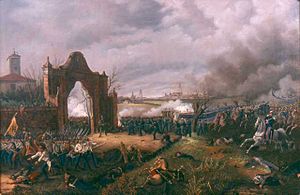Battle of Curtatone and Montanara
| First Italian War of Independence | |||||||||
|---|---|---|---|---|---|---|---|---|---|
| Part of the Wars of Italian Unification | |||||||||
 The Battle of Novara (1849) |
|||||||||
|
|||||||||
| Belligerents | |||||||||
|
Supported by: |
|
||||||||
| Commanders and leaders | |||||||||
|
|
|
||||||||
| Strength | |||||||||
|
|
|
||||||||
| Casualties and losses | |||||||||
|
1848: Unknown 1849: 17,400+ 2,400 killed 5,000 wounded 10,000 captured unknown disease deaths |
1848: 9,139 4,872 killed/missing 3,348 wounded 919 captured 1849: 6,441 1,145 killed/missing 2,944 wounded 352 captured 2,000+ disease deaths Total: 15,580+ |
||||||||
The First Italian War of Independence (Italian: Prima guerra d'indipendenza italiana) was part of the Risorgimento. It was fought by the Kingdom of Sardinia (Piedmont) and Italian volunteers against the Austrian Empire and other conservative states from 23 March 1848 to 22 August 1849 in the Italian peninsula.
The conflict was preceded by the outbreak of the Sicilian revolution of 1848 against the House of Bourbon-Two Sicilies. It was precipitated by riots in the cities of Milan (Five Days) and Venice, which rebelled from Austria and established their own governments.
The part of the conflict which was fought by King Charles Albert against Austria in northern Italy was a Royal war and consisted of two campaigns. In both campaigns, the Kingdom of Sardinia attacked the Austrian Empire and was defeated, losing the war as a result. The decisive events of the first and second campaigns were the battles at Custoza and Novara, respectively.
At the beginning of the royal war, the Kingdom of Sardinia was supported by the Papal States and the Kingdom of Two Sicilies, which then withdrew, having barely participated in the fighting at all. However, volunteers from the Papal and Neapolitan armies joined the other Italian volunteers and fought against Austria.
Alongside the royal war, revolutionary movements took place in various Italian states (Papal States, Tuscany, etc), part of the Revolutions of 1848 in the Italian states, which could not be reconciled with the Liberal ideals of Piedmont. Historiography treats these revolutions, as well as the Sicilian revolution of 23 March 1848, as a popular war, which also failed, ending in the restoration of traditional institutions and many rebels forced into exile.
...
Wikipedia
